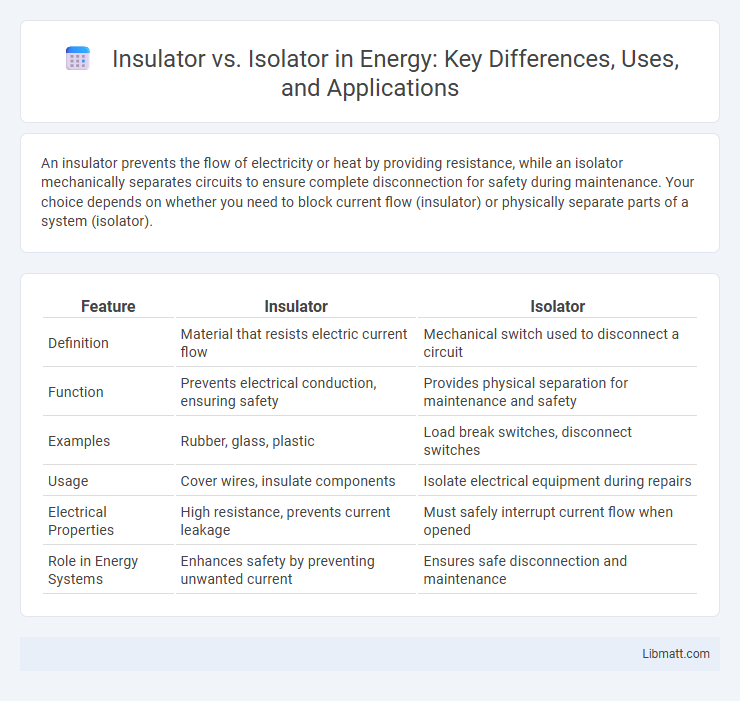An insulator prevents the flow of electricity or heat by providing resistance, while an isolator mechanically separates circuits to ensure complete disconnection for safety during maintenance. Your choice depends on whether you need to block current flow (insulator) or physically separate parts of a system (isolator).
Table of Comparison
| Feature | Insulator | Isolator |
|---|---|---|
| Definition | Material that resists electric current flow | Mechanical switch used to disconnect a circuit |
| Function | Prevents electrical conduction, ensuring safety | Provides physical separation for maintenance and safety |
| Examples | Rubber, glass, plastic | Load break switches, disconnect switches |
| Usage | Cover wires, insulate components | Isolate electrical equipment during repairs |
| Electrical Properties | High resistance, prevents current leakage | Must safely interrupt current flow when opened |
| Role in Energy Systems | Enhances safety by preventing unwanted current | Ensures safe disconnection and maintenance |
Introduction to Insulator and Isolator
Insulators are materials that prevent the flow of electric current by offering high resistance, commonly used in electrical wiring and equipment to ensure safety and efficiency. Isolators are mechanical switches designed to disconnect a part of the circuit, providing a visible break to ensure maintenance and operational safety in electrical systems. Both components play crucial roles in electrical engineering by protecting circuits and personnel from electrical hazards.
Defining Insulator: Key Characteristics
An insulator is a material that resists the flow of electric current, preventing energy loss and protecting circuits from short-circuits. Its key characteristics include high electrical resistance, thermal stability, and durability under varying environmental conditions. Understanding the properties of an insulator helps you select the right material for effective electrical insulation in your projects.
Understanding Isolator: Main Features
An isolator is an electrical device designed to ensure complete disconnection of a circuit or equipment from the power source for maintenance and safety purposes. Its main features include the ability to provide a visible break in the circuit, ensuring no current flows, and reliable mechanical interlocking to prevent accidental operation. Isolators are typically used in high-voltage systems to protect personnel and equipment during servicing.
Types of Insulators
Types of insulators include ceramic, glass, and polymer varieties, each offering distinct electrical resistance properties essential for preventing current leakage. Pin insulators are commonly used in overhead power lines, while suspension insulators support high-voltage cables, and strain insulators handle mechanical tension. Choosing the appropriate insulator type depends on factors like voltage level, environmental conditions, and mechanical stress requirements.
Types of Isolators
Isolators are critical components in electrical systems designed to ensure safety by physically disconnecting parts of a circuit for maintenance or fault isolation. Common types of isolators include the hinge type, center break type, double break type, and pantograph type, each offering distinct mechanical designs and operational advantages. Your choice of isolator depends on system voltage, installation environment, and the specific isolation requirements to maintain reliable electrical safety.
Differences Between Insulator and Isolator
Insulators are non-conductive materials designed to prevent the flow of electric current by providing resistance, commonly used in electrical wiring and equipment to ensure safety. Isolators are mechanical switches that physically separate parts of an electrical circuit, ensuring complete disconnection for maintenance or repair, often found in high-voltage power systems. Understanding the differences between insulators and isolators is crucial for managing your electrical safety and system reliability effectively.
Applications of Insulators
Insulators are critical in electrical systems to prevent unwanted current flow and protect equipment from damage. They are commonly used in power transmission lines, electrical substations, and circuit boards to ensure safety and efficiency. Your electrical infrastructure relies on insulators to maintain system integrity by separating conductive parts and avoiding short circuits.
Applications of Isolators
Isolators are widely used in electrical and electronic applications to disconnect parts of a circuit or system for maintenance without interrupting the entire operation, ensuring safety and continuity. In power systems, isolators facilitate safe isolation of transformers, circuit breakers, and other equipment for inspection or repair. Their role is critical in substations, switchyards, and industrial plants where reliable separation of live parts is essential to prevent electrical hazards and equipment damage.
Advantages and Disadvantages: Insulator vs Isolator
Insulators provide excellent electrical resistance, preventing current flow and minimizing energy loss, but they can be brittle and prone to damage under mechanical stress. Isolators offer reliable circuit disconnection for maintenance and safety, ensuring complete de-energization, yet they can cause power interruptions and require manual operation. Both components are essential in electrical systems, with insulators optimizing performance by reducing leakage and isolators enhancing safety through physical separation.
How to Choose: Insulator or Isolator for Your Needs
Choosing between an insulator and an isolator depends on your specific electrical safety and operational requirements. Insulators prevent current flow by physically separating conductive components, ideal for everyday electrical devices and wiring. Isolators, designed to disconnect sections of a circuit completely, ensure safe maintenance and isolation of equipment, making them crucial in high-voltage power systems.
Insulator vs Isolator Infographic

 libmatt.com
libmatt.com